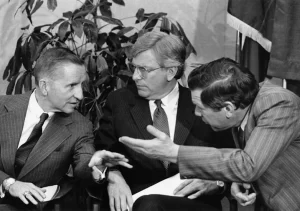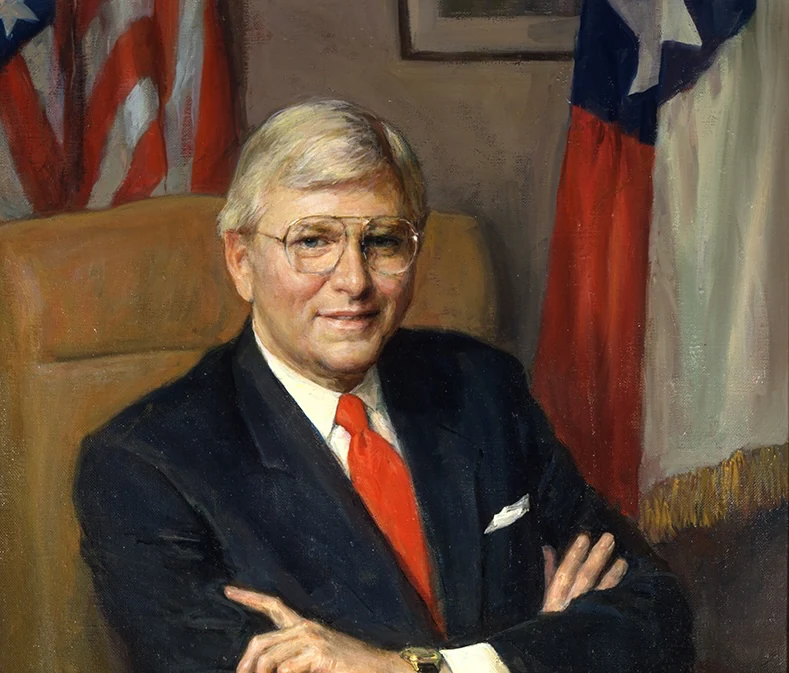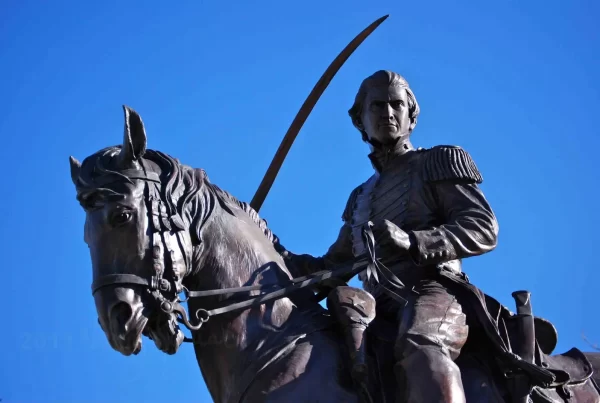Mark Wells White Jr. (March 17, 1940 – August 5, 2017) served as the forty-third governor of Texas from 1983 to 1987, remembered for bold education reforms and for leading the state during the turbulence of the mid-1980s oil bust. A Democrat from Houston, he rose through state office as secretary of state and attorney general before capturing the governorship in 1982. His tenure, though only one term, left an imprint on Texas politics as the last moment of Democratic statewide dominance before the state’s long conservative realignment.
Early Life and Legal Career
White was born in Henderson, Texas, the son of Mark Wells White Sr. and Sarah Elizabeth (Wells) White. His family moved to Houston in 1942, where he attended public schools and graduated from Lamar High School. He went on to Baylor University, earning a business administration degree in 1962 and a law degree from Baylor Law School in 1965. In 1966 he married Linda Gale Thompson, and together they raised three children.
After law school, White entered private practice and served as an assistant attorney general from 1966 to 1969, handling a variety of cases for the state. He returned to private practice in Houston before joining the Joe Reynolds law firm in 1972. His career trajectory shifted when fellow Democrat Dolph Briscoe was elected governor that year. Briscoe soon tapped White for a political career of his own.
Secretary of State and Attorney General
In 1973, Briscoe appointed White as secretary of state. Briscoe later explained why he made the selection: “Mark was a brilliant and ambitious young lawyer as well as an extremely personable young man. I felt that he would make an excellent secretary of state.”
Briscoe recalled White’s talent as a persuasive advocate for the governor’s legislative program, particularly in working with Lieutenant Governor Bill Hobby and the Texas Senate. White’s energy and ambition quickly gained recognition, and in 1977 he was elected president of the National Association of Secretaries of State.
In 1978, White sought higher office, running for attorney general. He won the Democratic nomination over Price Daniel Jr. and then defeated Republican nominee James A. Baker III, a prominent Houston lawyer who would later serve as White House chief of staff and U.S. secretary of state. White served as attorney general from 1979 to 1983, participating in national law enforcement councils and positioning himself for a run at the governorship.
The 1982 Gubernatorial Victory
White entered the 1982 governor’s race against incumbent Republican Bill Clements, who had become the first Republican governor of Texas since Reconstruction. Clements’s tenure coincided with early economic headwinds, and White capitalized on Democratic strength that year. With U.S. Senator Lloyd Bentsen and Lieutenant Governor Bill Hobby also on the ballot, Democrats swept the statewide offices for the last time in Texas history. White won with 53 percent of the vote, ushering in a new administration.
The 1982 election was the last great moment of Texas Democratic hegemony. Nationally, the Reagan Revolution was in full force, and the state would soon align with Republican conservatism. White took office as the Democratic Party’s final transitional figure before that tide.
Governor of Texas (1983–1987)

White’s governorship is remembered above all for education reform. Early in his tenure he appointed a committee chaired by Dallas businessman Ross Perot to study Texas public schools. The resulting legislation, House Bill 72 of 1984, overhauled the system by raising teacher pay, instituting mandatory competency tests, reorganizing the State Board of Education, and enacting the famous “no pass, no play” rule that required students to pass all classes in order to participate in extracurricular activities.
The policy reflected White’s conviction that Texas needed a modernized education system to prepare for a changing economy. Yet it was deeply controversial, particularly in football-loving Texas communities where athletes lost eligibility.
White defended the rule with personal appeals, including a televised advertisement in which he recounted a mother’s words: “His father and I didn’t send him to school to play. We sent him to learn. Even if he makes the team, he won’t be a professional ballplayer. But if he doesn’t pass his classes, he’ll never be a professional anything.”
“Perot [and White] took on the greatest power in all of Texas: football. The trouble with Texas schools, said Perot, is too much football. Pretty much the whole state flat fell down on hearing such heresy, bewildered as a goat on AstroTurf. The widespread consensus in Texas was that schools exist primarily to support football. Here Ross Perot up and proposed no-pass/no-play. If you don’t pass all your courses in school, you can’t play football. People were astounded, and it upset the coaches. In Texas politics, it is not wise to upset the coaches.”
— Molly Ivins, newspaper columnist, author, and political commentator
Bill Hobby later remembered: “HB 72, (no pass, no play) was the greatest piece of education legislation passed in many years.” Voters disagreed, and the unpopular education bill likely contributed to White’s reelection loss in 1986.
Advertisement
Despite this, the “no pass, no play” provision of House Bill 72 outlived White’s governorship, though in a softened form. Initially, any failing grade barred a student from all extracurricular activities for six weeks. In 1995, lawmakers modified the rule to allow students to fail one class and to shorten the suspension period to three weeks. The original standard was eased, but the principle White championed—that athletics and other activities must be secondary to academics—remains embedded in Texas education policy.
White also made history with his appointments. He named Elma Salinas Ender the first Hispanic woman to serve as a Texas district judge, and he appointed Myra McDaniel as secretary of state in 1984, the first African American to hold that position. His administration also enacted a new seat belt law and expanded workers’ compensation coverage for farm workers. These steps signaled White’s commitment to modernization and inclusivity in state government.
Economic Crisis and the Oil Bust
White governed during one of the harshest economic downturns in modern Texas history. The collapse of global oil prices in the mid-1980s devastated the state’s petroleum-dependent economy, driving unemployment up and triggering a banking crisis.
In 1986, with state revenues collapsing, White called a special legislative session and asked for both budget cuts and a temporary tax increase. “We need a temporary tax increase to save education and build our future. I’ll defend it. I’ll explain it. And to those who try to blame you for what we do here, tell them we had to do it. Blame me,” White declared. The choice reflected his governing philosophy: prioritizing education even at political risk.

1986 Election Defeat
That risk proved costly. In 1986, Clements staged a comeback and defeated White in a rematch, winning 52.7 percent of the vote. Many analysts attributed White’s loss to economic pain and the unpopularity of “no pass, no play.” In his farewell address to lawmakers, White joked ruefully: “I asked for a tax increase and said, ‘Blame me,’ and you did.”
The defeat marked not only the end of White’s governorship but also the waning of Democratic control. Within a few years, Republicans would dominate Texas statewide offices, and White’s tenure would be remembered as a pivot point in the state’s partisan history.
Later Career and Civic Life
White attempted a political comeback in 1990 but finished third in the Democratic primary behind Ann Richards and Jim Mattox. He returned to private practice in Houston, founded a security technology company called Geovox Security, and became active in civic affairs. He chaired the Houston Independent School District Foundation and served on advisory boards at the University of Houston’s Hobby School of Public Affairs.
Though a supporter of the death penalty while governor, presiding over 22 executions, White later expressed misgivings. In 2010, citing the case of Cameron Todd Willingham, he said wrongful executions were possible and voiced openness to abolition.
In 2008, he drew attention for endorsing Barack Obama over Hillary Clinton in the Democratic primaries, saying: “Barack’s vision is exactly what our nation needs right now. He offers America the opportunity to move beyond the divisive politics and moneyed special interests and start addressing the many great challenges we face as a nation.” His willingness to break with the Texas Democratic establishment reflected the same independence that had marked his career.
Death and Legacy
White died of a heart attack at his Houston home on August 5, 2017, at age 77, after battling kidney cancer for several years. His funeral at Houston’s Second Baptist Church drew governors past and present, including George W. Bush, Rick Perry, and Greg Abbott. He was later interred at the Texas State Cemetery in Austin.
Across the political spectrum, tributes emphasized his integrity and commitment to public education. Rep. Garnet Coleman remembered: “Governor White’s courage to do what was best instead of what was easy or popular made him a great statesman.” Alice Aanstoos, chair of the Hobby School advisory board, described him as “a true gentleman, a scholar, a genuine public servant and a great story-teller.”
Others highlighted his wit. Saralee Tiede recalled him quipping during a policy discussion: “Slavery was good for the economy but that doesn’t make it right.”
White’s legacy is tied most of all to education reform. Though politically costly, his initiatives changed the culture of Texas schools and signaled that state government would no longer defer entirely to local athletic priorities.
The most famous provision of House Bill 72, “no pass, no play,” outlived White’s governorship, though in a softened form. Initially, any failing grade barred a student from all extracurricular activities for six weeks. In 1995, lawmakers modified the rule to allow students to fail one class and to shorten the suspension period to three weeks. The original standard was eased, but the principle White championed—that athletics and other activities must be secondary to academics—remains embedded in Texas education policy.
At the same time, his governorship illustrates the fragility of Democratic power in 1980s Texas: even reformers with statewide popularity could not withstand the economic and political currents of the Reagan era.
White and his wife Linda Gale had three children. Their son Andrew White entered politics in 2018, running for governor in the Democratic primary. He advanced to a runoff against Lupe Valdez but was narrowly defeated. Though unsuccessful, his candidacy showed the endurance of the White name in Texas politics a generation after his father’s service.
Mark White’s governorship came at a turning point in Texas history. He championed education reform, diversification of the economy, and inclusivity in appointments, even as collapsing oil prices and shifting political winds undercut his popularity. His decision to risk political survival for education funding cost him reelection but secured his reputation for integrity. Remembered as both reformer and casualty of the oil bust, White remains a symbol of the state’s transition from Democratic tradition to Republican ascendancy.



